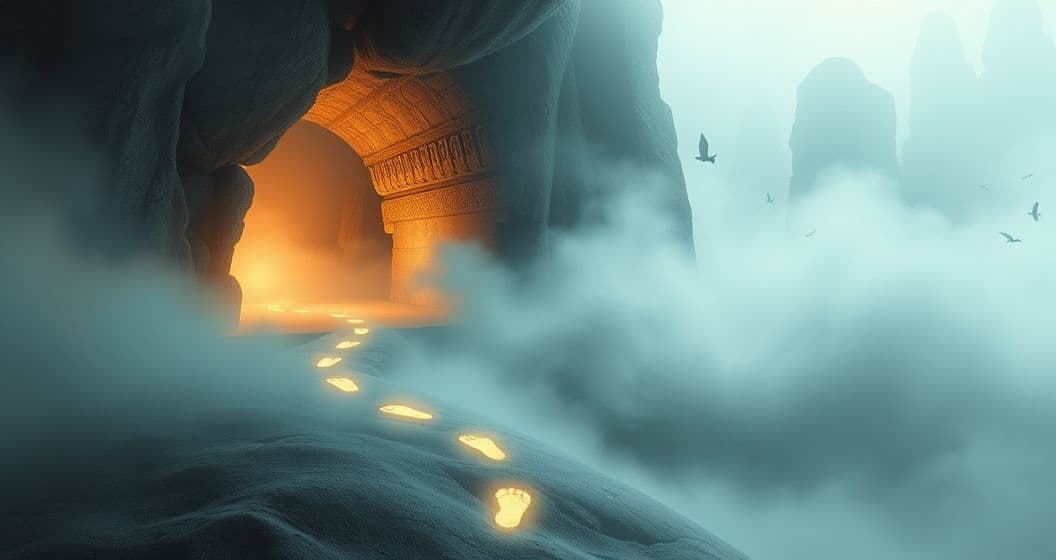Core Symbols: Footprints and Chambers in Dreams
Footprints in dreams are more than mere representations of movement—they embody the cumulative story of your actions, choices, and progress. Each step you trace in sleep often reflects the emotional weight of your waking journey: fresh, vibrant footprints might signal newfound confidence, while faded or overlapping prints could hint at uncertainty about your path. In the context of dream symbolism, footprints also carry the weight of legacy—they ask you to consider how your past steps have shaped your present and future. Imagine a dream where you follow your own footprints through a misty forest; this isn’t just about walking—it’s about recognizing the trail you’ve already laid, even if you’ve forgotten parts of it.
Chambers, by contrast, are portals to the unknown recesses of your mind. These symbolic spaces can represent emotional safe havens, hidden memories, or thresholds to self-discovery. A chamber might appear as a locked room in a familiar house, a stone vault in an ancient temple, or even a luminous cave—each variation carrying subtle clues about what your subconscious is urging you to explore. In myth and psychology alike, chambers often symbolize the unconscious mind’s archives: a place where unresolved emotions, forgotten truths, or untapped potential reside. When footprints lead toward a chamber, the dream is whispering, ‘Your journey has prepared you to enter this space—now what do you seek to uncover?’
Psychology Lens: From Jungian Paths to REM Sleep
Want a More Personalized Interpretation?
Get your own AI-powered dream analysis tailored specifically to your dream
🔮Try Dream Analysis FreeCarl Jung’s concept of the individuation process offers rich context for footprints and chambers. He viewed dreams as messengers from the collective unconscious, guiding us toward self-integration. Footprints, in this framework, represent the steps of your unique path toward wholeness, while chambers are the ‘inner temples’ where you confront archetypal aspects of yourself—your shadow, your anima, or your innermost desires. Jung might interpret a dream of footprints to a chamber as a call to reconcile fragmented parts of your identity, much like a traveler mapping their way to a sacred site.
Sigmund Freud, meanwhile, would likely frame these symbols through the lens of repressed memories and unconscious urges. A chamber could hide repressed childhood experiences, while footprints might be the subconscious’s way of retracing steps to revisit or resolve those memories. Yet modern neuroscience adds another layer: during REM sleep, the brain processes emotional memories, consolidating them into long-term storage. Footprints might thus reflect your emotional mind sorting through recent experiences, while chambers represent the ‘storage vaults’ where unresolved feelings take root.
Life Triggers: When Do These Dreams Arise?
Footprints leading to chambers often surface during periods of transition—when you’re at a crossroads in life, whether literal (starting a new job) or metaphorical (redefining your identity). If you’re navigating uncertainty, the dream may mirror your subconscious’s attempt to make sense of your choices: the footprints are the steps you’ve taken so far, and the chamber is the new space you’re tentatively approaching. For example, a creative professional might dream of footprints leading to a music studio chamber after months of self-doubt, signaling a need to reconnect with their artistic purpose.
Digital-age living also influences these symbols: footprints could represent your online presence or digital legacy, while chambers might symbolize the offline ‘inner sanctum’ you’re neglecting. If you’ve been overworking or numbing emotions with screens, the dream might urge you to step back and explore the ‘chamber’ of your true self, free from digital noise.
What To Do Next: From Reflection to Action
Start with short-term reflection: Keep a dream journal noting the details of your footprints and chamber. Ask: What direction were the footprints leading? Did the chamber feel inviting or threatening? This curiosity helps you decode the emotional subtext of your journey. Next, experiment with medium-term exploration: If the chamber felt like a creative space, try a new artistic project; if it felt like a personal space, schedule time for self-care rituals that honor your needs.
For long-term integration, align your actions with the path the footprints suggest. If the dream showed you following a winding trail to a sunlit chamber, set small, intentional steps toward that goal—whether it’s learning a skill, mending a relationship, or pursuing a passion. Remember: the footprints are yours, and the chamber is waiting to be claimed by the courage to explore.
FAQ
Q: What if I don’t remember the footprints clearly?
A: Dreams often leave emotional residues. Focus on how the dream made you feel—curious, anxious, or peaceful—and note recurring emotions, as they reveal the subconscious’s priority.
Q: Why do I dream about chambers but not footprints?
A: Chambers alone may signal a need for introspection without action yet. The footprints represent the ‘how’ of moving forward; if missing, you might be stuck in overthinking or fear of commitment.
Q: How do I tell if the chamber is positive or negative?
A: Look at the emotional tone: warm light, open doors, or familiar surroundings suggest positive growth. Dark, locked, or unfamiliar chambers may signal unresolved fears—an invitation to face them.
